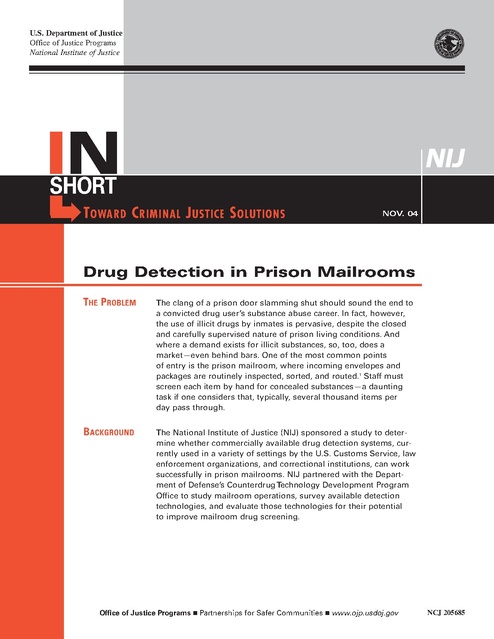Doj Report on Drug Detection in Prison Mailrooms
Download original document:

Document text

Document text
This text is machine-read, and may contain errors. Check the original document to verify accuracy.
U.S. Department of Justice Office of Justice Programs National Institute of Justice IN SHORT ➡ T OWARD C RIMINAL J USTICE S OLUTIONS NOV. 04 Drug Detection in Prison Mailrooms THE PROBLEM The clang of a prison door slamming shut should sound the end to a convicted drug user’s substance abuse career. In fact, however, the use of illicit drugs by inmates is pervasive, despite the closed and carefully supervised nature of prison living conditions. And where a demand exists for illicit substances, so, too, does a market—even behind bars. One of the most common points of entry is the prison mailroom, where incoming envelopes and packages are routinely inspected, sorted, and routed.1 Staff must screen each item by hand for concealed substances—a daunting task if one considers that, typically, several thousand items per day pass through. BACKGROUND The National Institute of Justice (NIJ) sponsored a study to deter mine whether commercially available drug detection systems, cur rently used in a variety of settings by the U.S. Customs Service, law enforcement organizations, and correctional institutions, can work successfully in prison mailrooms. NIJ partnered with the Depart ment of Defense’s Counterdrug Technology Development Program Office to study mailroom operations, survey available detection technologies, and evaluate those technologies for their potential to improve mailroom drug screening. Office of Justice Programs ■ Partnerships for Safer Communities ■ www.ojp.usdoj.gov NCJ 205685 2 THIS STUDY The research team observed and analyzed the mailroom processes of the U.S. Penitentiary in Leavenworth, Kansas. They then conducted a market survey to find suit able and available detection equipment. Next, at Thunder Mountain Evaluation Center in Arizona, they performed a laboratory-based evaluation of several trace detection instruments—desktop and handheld ion mobility spectrometers (IMS) and a chemical reagent spray—and a bulk detection (x-ray) machine to determine, for each piece of equipment shown below, the minimum detection limits for the six drugs of interest (marijuana, cocaine, heroin, methamphetamine, ecstasy, and LSD). Detection Class Type of Equipment Cost of Equipment Trace Desktop IMS $40,000–45,000 Trace Handheld IMS $20,000–25,000 Trace Chemical Spray $200–500 per kit Bulk X-ray Machine $60,000 The team also created a mock mailroom at Thunder Mountain to evaluate background levels of substances within the postal system and the ability of each technology to detect varying amounts of marijuana and cocaine concealed within mailing envelopes. BOTTOM LINE Researchers found that: ■ The x-ray system could find relatively small amounts of drugs in mail as long as the substances were in a compacted form. ■ In some cases, the trace detection systems had high false alarm rates, judged to be the result of “spiked” mail contaminating clean mail during testing and of improper adjustment of equipment alarm levels. ■ Items mailed through the postal system do not pick up substantial amounts of drug contamination. Researchers concluded from the scenario evaluation that ion mobility spectrometry is the technology most likely to enhance mailroom drug-screening effectiveness. LIMITATIONS Most of the drugs chosen for investigation are difficult to handle and degrade easily over time; thus, only cocaine and marijuana were used in the simulated mailroom evaluation. However, researchers were able to use the initial laboratory-based evalua tion data to predict results for the four drugs not tested in the mailroom scenario. In addition, the study only focused on the ability of a technology to detect the presence of concealed drugs in the mail. It did not evaluate the speed and efficiency of the tech nologies, nor did it create or evaluate screening methods for large volumes of mail; however, a followup evaluation of ion mobility spectrometers studied various tech niques for sampling the mail in batches to reduce overall screening time. WHAT’S NEXT? IMS equipment is currently being evaluated in actual prison mailrooms to determine its operational effectiveness and any impact it might have on workflow, staff accept ance, and training and maintenance requirements. The combination of technical data and workflow impact results will be used to develop a strategy for using this technolo gy to improve the efficiency and effectiveness of drug screening in Federal, State, and local prison mailrooms. . AUDIENCE Prison administrators, prison mailroom inspectors, corrections officers, and policymakers. FIND THIS STUDY The full report of the Mailroom Evaluation Scenario is available online at http://www.ncjrs.org/pdffiles1/nij/grants/199048.pdf. NOTE 1. See pages iii–vii in The Federal Bureau of Prisons’ Drug Interdiction Activities, Report No. I–2003–002, U.S. Department of Justice, Office of the Inspector General, Evaluation and Inspections Division, January 2003. For more information on drug detection in the criminal justice system, visit the National Criminal Justice Reference Service and browse the topic “Drugs and Crime” at: http://fulltextpubs.ncjrs.org/content/FullTextPubs.html Also see the following NIJ publications: Color Test Reagents/Kits for Preliminary Identification of Drugs of Abuse, NIJ Standard 0604.01, July 2000 http://www.ncjrs.org/pdffiles1/nij/183258.pdf Guide for the Selection of Drug Detectors for Law Enforcement Applications, NIJ Guide 601–00, August 2000 http://www.ncjrs.org/pdffiles1/nij/183260.pdf This document is not intended to create, does not create, and may not be relied upon to create any rights, substantive or procedural, enforceable at law by any party in any matter civil or criminal. Opinions or points of view expressed in this document represent a consensus of the authors and do not represent the official position or policies of the U.S. Department of Justice. The products and manufacturers discussed in this document are pre sented for informational purposes only and do not constitute product approval or endorsement by the U.S. Department of Justice. 3 U.S. Department of Justice Office of Justice Programs National Institute of Justice *NCJ~205685* Washington, DC 20531 Official Business Penalty for Private Use $300 Drug Detection in Prison Mailrooms IN SHORT ➡ T OWARD C RIMINAL J USTICE S OLUTIONS PRESORTED STANDARD POSTAGE & FEES PAID DOJ/NIJ PERMIT NO. G–91





